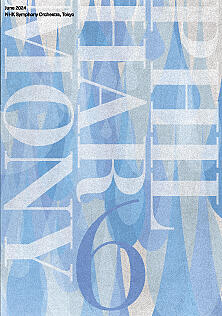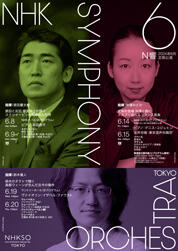- Home
- Concerts
- Subscription Concerts 2023-2024
- Program B
- No. 2015 Subscription (Program B)
No. 2015 Subscription (Program B)
Suntory Hall
Google Map Seating Chart
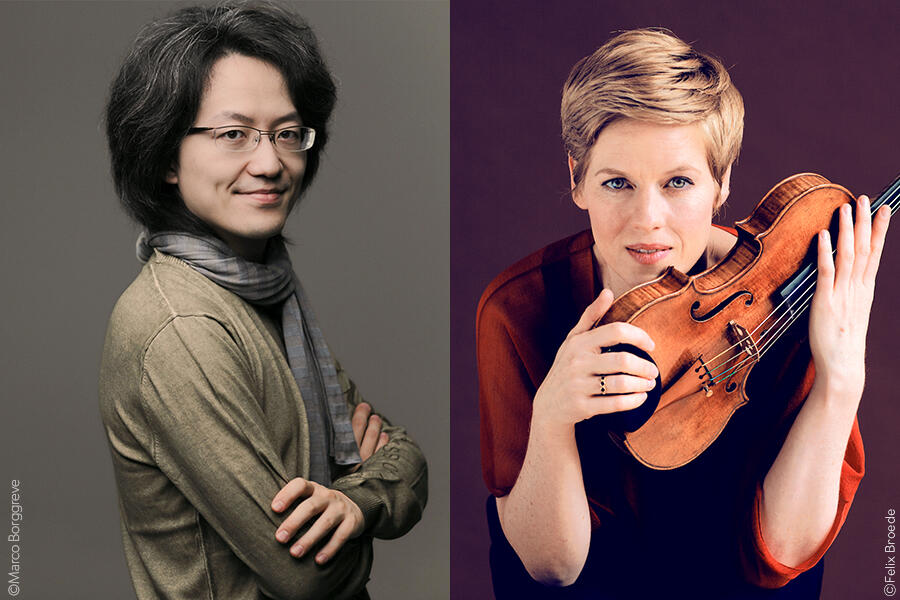
Program
Webern / Passacaglia Op. 1
Vienna became a capital of music with the First Viennese School trio Haydn, Mozart and Beethoven, whilst younger Schubert spearheaded the Romanticism in the same city. As time passed, the early 20th century saw the appearance of the Second Viennese School trio, Schönberg (described below), his disciples Webern and Berg. The three composers developed an atonal language free from any major/minor key. Then in 1921, Schönberg fully established the twelve-tone technique, which changed the course of modern music history.
Born into a noble family in Vienna, Webern started to take piano / cello lessons and compose in his teenage years. After studying musicology, harmony and counterpoint at the University of Vienna, he was privately apprenticed to Schönberg in 1904–1908. Later, the devoted pupil went on to adopt the twelve-tone technique more strictly than his venerable teacher.
Webern made his official debut with his op. 1, Passacaglia (1908), written at age 24 as a fruit of his four-year training under Schönberg. Still under the influence of the late-Romantic style (especially of Wagner and early Schönberg), the work dates from the period shortly before Webern renounced the tonal language. It is globally chromatic (with halftones) producing tonal ambiguity, despite the eight-note D-minor theme given by the strings’ pizzicatos at the outset. Following the Baroque uninterrupted variation form “passacaglia,” the theme is then repeated twenty-three times (in D major in the middle of the piece) previous to the extended coda.
[Kumiko Nishi]
Schönberg / Violin Concerto Op. 36
Born into a Jewish family in Vienna 150 years ago, Schönberg set foot in the music world through violin lessons he first took at age 8 and started to compose before long. As a composer he was self-taught except for some short-term instruction young Schönberg received from his friend Alexander von Zemlinsky (1871–1942).
As stated above, Schönberg is counted among a handful of revolutionary composers in history by establishing atonal music around the late 1900s, and then the twelve-tone technique (dodecaphony) in 1921. The technique of treating all the twelve notes of an octave equally meant the dissolution of what the traditional harmonies had been depending upon— the hierarchy of the keys and notes. In 1921, he reportedly said that his method “will ensure the supremacy of [Austro-]German music for the next hundred years.” Twelve years later, ironically, Nazi Germany forced the Jewish composer to emigrate to the USA. After teaching for a year on the East Coast, he, plagued by ill health, moved to warm California in 1934 and spent the rest of his life there.
Dating from his early Californian period, the Violin Concerto (1936) is dedicated to his disciple Webern. The work has the Classical fast-slow-fast-movement design, whereas it is meticulously constructed with the twelve-tone technique. The first movement begins with the violin solo and cellos stating the prime twelve-tone “row” and then its inversion in a moment (some notes are heard at the same time), before the soloist plays the row plainly (A–B♭–E♭–B–E– F♯–C–C♯–G–A♭–D–F). The beginning of the lyrical slow movement in A–B–A form lets the soloist sing the same prime row, but starting from E (E–F–B♭–G♭–C♭…). The jocular rondo finale also has the soloist give the prime row at the outset, this time in inversion, starting from D (D–C♯–G♯–C–G…). Overall, the concerto brilliantly shows how diverse a work on a single twelve-tone row can be in melody, harmony, texture, character and so forth.
[Kumiko Nishi]
J. S. Bach / Webern / Ricercata
Schönberg and Anton Webern (1883–1945) famously favored Johann Sebastian Bach (1685–1750). Apart from their adoptions of Baroque forms, their aforesaid twelve-tone technique was clearly inspired by Bach’s supreme contrapuntal (polyphonic) writings, especially his highly systematic but also inventive fugues. Incidentally, Webern’s involvement in the past music spanned as early as the pre-Baroque era: he earned a doctorate in musicology at the University of Vienna in 1906 editing the second volume of the Renaissance composer Heinrich Issac’s Choralis constantinus, a collection of sacred polyphonic songs based on Gregorian chants.
Dating from Webern’s late period, Ricercata (1935) is an orchestration of Bach’s six-part Ricercar (fugue) from Das Musikalische Opfer (The Musical Offering) (1747). Webern’s version could be considered a re-creation above and beyond an arrangement due to its uniqueness, even though he didn’t alter Bach’s original notes. The major reason is the utilization of Schönberg’s “Klangfarbenmelodie (sound-color melody)” that Webern absorbed. This technique of entrusting a melody to different instrumental timbres in turn, often described “pointillistic,” will have a great influence on avant-garde composers after World War II. At the opening of Ricercata, Webern thus assigns a trombone, a horn and a trumpet, one by one, the announcement of the fugue’s “theme of king” that Frederick the Great gave to Bach. The theme is then orchestrated following “Klangfarbenmelodie” at every entry, before being “played out” at last by cellos, contrabasses, a bassoon and a bass clarinet in unison at the close.
[Kumiko Nishi]
Schubert / Symphony No. 5 B-flat Major D. 485
Franz Schubert (1797–1828), who uttered his first cry in a kitchen alcove in a Vienna suburb, is a born and bred Viennese. This is actually a rare case, considering none of the First Viennese School masters, Haydn, Mozart and Beethoven were “native” to the city, let alone the Italian composer Salieri who was the Viennese Court’s music director and Schubert’s composition teacher.
In his school days at the Stadtkonvikt (imperial seminary), Schubert became familiar with works by Haydn, Mozart and Beethoven, performing in and conducting the seminary’s student orchestra for which he also composed. According to his school fellow Spaun, Mozart’s G-minor Symphony No. 40 and Beethoven’s D-major Symphony No. 2 particularly impressed Schubert. After entering the teaching profession in 1814, he continued to compose. The next year was the most prolific in his entire life, and his creativity still overflowed in 1816 producing numerous pieces including the Symphony No. 5. The work was privately premiered the same year in the home of his friend and violinist Otto Hatwig in Vienna. It would be publicly heard after the composer’s death, as with all of his other symphonies.
The most evident features of No. 5 are the absence of a slow introduction at the cheerful opening sonata movement as well as the compact instrumentation without clarinet, trumpet, trombone and timpani. Moreover, Mozart’s influence upon the work is almost always pointed out. For instance, the slow second movement in rondo form (A–B–A–B–A–coda) has the graceful recurrent theme which recalls the main melody of the minuet movement from Mozart’s Violin Sonata K. 377. A more striking example is Schubert’s entire third movement. This fiery G-minor minuet having the G-major trio (central) section resembles the G-minor minuet from Mozart’s Symphony No. 40, Schubert’s favorite as mentioned above. The final sonata movement evokes the Salzburger genius as well: its vivacious, witty, operatic nature reminds us of, for example, the overture for Le nozze di Figaro (The Marriage of Figaro). Nevertheless, the symphony as a whole is abundant in poetic songfulness and unpredictable, adventurous harmonies typical of Schubert.
[Kumiko Nishi]
[Encore]
June 19: Nicola Matteis I / Ayres for the Violin, Book II- Passagio Rotto
June 20: Louis-Gabriel Guillemain / Amusement pour le violon seul compose de plusieurs airs varies de differens auteurs, Op. 18
Violin: Isabelle Faust
Artists
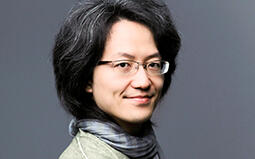 ConductorMasato Suzuki
ConductorMasato Suzuki
After graduating from the Tokyo University of the Arts and its graduate school, Masato Suzuki completed the master’s course of the Royal Conservatory of The Hague in the Netherlands. His activities as conductor, composer, pianist, harpsichordist, and organist are truly remarkable. In addition, he is the executive producer of the Chofu International Music Festival, and is also popularly known to public as the guide to NHK-FM’s program titled The Joy of Early Music. As Music Director of Ensemble Genesis, he takes up a wide variety of works from various eras performing with period instruments, he also serves as Principal Conductor of the Bach Collegium Japan, Conductor/ Creative Partner of the Yomiuri Nippon Symphony Orchestra, and Principal Guest Conductor of Kansai Philharmonic Orchestra. With his flexible approach to works of any kind, he has made remarkable achievements in both period instruments ensembles and modern orchestras.
It was the December subscription concert of 2019 when he made his debut with the NHK Symphony Orchestra, however, he has established a good rapport with the orchestra through prior engagements as an organ soloist in November 2018 and May 2019. The June subscription concert program he conducts includes Webern’s early romantic work, a concerto using the twelve-tone technique by Schönberg, Webern’s tutor, an orchestration of Great Bach’s work arranged by Webern and a symphony by Schubert. Thus, it is made highly interesting, with all works related to Vienna but from different eras, and of different composition styles. It certainly
arouses audience expectation.
[Nobuyasu Matsuoka, music critic]
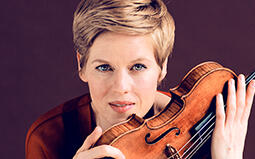 ViolinIsabelle Faust
ViolinIsabelle Faust
Is there any other violinist who is more dedicated to music than Isabelle Faust is? What makes her great is that while demonstrating her vivid technique in her performances of unaccompanied pieces including dance pieces, New Viennese School works, and exquisite modern and contemporary works, she has a philosophy to pursue and highlight the background and message conveyed by the music she performs.
Isabelle Faust, one of the greatest artists of our time, who opens up the creative horizon with the dignified and yet beautiful sounds she produces, will return to the NHK Symphony Orchestra for the first time since February 2021 when she performed Szymanowski’s 1st Violin Concerto (conducted by Masaru Kumakura). Isabelle Faust studied with the renowned violinists Christoph Poppen and Dénes Zsigmondy, and won the 1st International Violin Competition Leopold Mozart (Augsburg) in 1987, the International Violin Competition “Premio Paganini”
(Genova) in 1993, and jumped into the spotlight. However, she never hastened to build up her international career, instead she studied further in her native Germany as well as in France and Switzerland. Her performances in recent years have become even more refined, and she has won artistic acclaim in the project to commemorate the 100th anniversary of György Ligeti’s birth. Schönberg’s Violin Concerto (1936), which she will play on this occasion, is one of her specialties, and she recorded this work with the Swedish Radio Symphony Orchestra under Daniel Harding in 2019.
[Yoshimichi Okuda, music critic]
Download
Ticket
Program B
No. 2015 Subscription (Program B)
Suntory Hall
Google Map
Seating Chart
Single Tickets Release Date
Pre-sales for Subscribers:Wednesday, February 28, 2024
*about subscribers
Sale to General Public:Sunday, March 3, 2024
Price
| S | A | B | C | D | |
|---|---|---|---|---|---|
| Ordinary Ticket | 9,800 | 8,400 | 6,700 | 5,400 | 4,400 |
| Youth Ticket | 4,500 | 4,000 | 3,300 | 2,500 | 1,800 |
Seating chart Enlarge Print PDF
*tax included
*Subscribers receive a 10% discount (Available at NHKSO WEB Ticket and N-Kyo Guide)
*For wheelchair-accessible seats, please refer to the N-Kyo Guide
Youth Tickets
Youth Tickets are great options for those of 25 years old and younger
Subscription tickets
Release Date
ANNUAL SUBSCRIPTION TICKETS
Mon., July 17, 2023 10:00am
[For Subscribers: Sun., July 9, 2023 10:00am]
Where to buy
NHKSO WEB Ticket | Wednesday, June 19 (In English / Seats not selectable)
NHKSO WEB Ticket | Thursday, June 20 (In English / Seats not selectable)
NHKSO WEB Ticket (In Japanese only / Seats selectable)
N-Kyo Guide (Purchase by telephone only)
*Repertoire, conductor, soloists and program order are subject to change without notice.
*Pre-school children are not allowed in the concert hall

